Pie Restaurant Business Plan
UPer Crust Pies specializes in meat, vegetable, and fruit pies made using old-country traditional family recipes from the UP – Michigan’s Upper Peninsula. Our pies are baked fresh daily and sold hot in our retail stores. We also offer frozen pies in lunch and family sizes that can be cooked at home. Our products are low fat and free of genetically modified ingredients and are complemented by a selection of fresh premium salads and desserts.
By importing our products directly from a private label bakery in the UP, we avoid high labor costs, expensive manufacturing and production equipment, and additional warehousing and facility costs. Our main expenses are limited to product purchasing, shipping, and cold storage.
We plan to expand our company through retail outlets and aim to develop a franchise-friendly business model. With an exclusive import license, we can also sell frozen products through supermarkets and wholesale food chains, establishing ourselves as the market leader.
We have identified four keys to our success: securing highly visible store locations, offering a unique value-for-money product line, focusing on superior customer service and education, and retaining employees through training and promotion.
The proposed location for our first store will be in downtown Yubetchatown. We are considering five possible sites in three areas. UPer Crust Pies will target three market segments within the metro district: young adults and business people (42%), families with children (36%), and 15-24 year olds, including students (22%).
Our marketing strategy is to attract new customers, educate them, and build a loyal customer base. We plan to use highly visible signage, print media advertising, flyers, entertainment book coupons, word-of-mouth advertising, and strategic alliances.
Our sales strategy includes hiring employees who enjoy their jobs. We will continually assess all aspects of the business, interact with customers personally, and evaluate food choices for popularity, keeping favorites on the menu while offering weekly and seasonal specials.
UPer Crust Pies is a Limited Liability Company owned by Lina and Olie Mackinac-Gogebic. We plan to raise capital through a bank loan and private investments. These funds will primarily be used for corporate design, remodeling, and lease payments three months prior to opening.
Start-up costs include initial inventory, shipping, and cold storage fees. We also need to purchase equipment assets such as a commercial oven, pie warmers, display cases, refrigerators, freezers, and one-time furnishings. Additionally, we anticipate the need for liquid cash to cover operating and unforeseen expenses, as well as wages for the first three months of business.
We have forecasted a modest growth rate for the first year of business, adding two more stores in the second year, and an additional two stores in the third year. This expansion will increase gross revenue compared to industry standards while maintaining a conservative growth rate for the first three years.
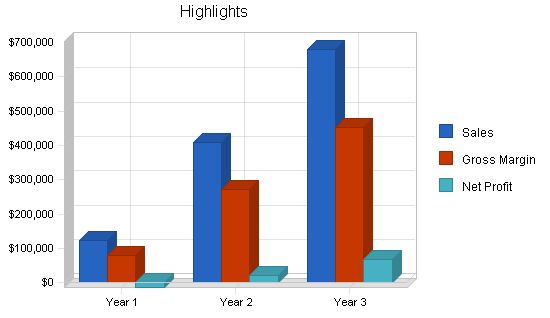
1.1 Objectives:
– Achieve first year sales above $120,000.
– Maintain a healthy average gross margin.
– Develop a business model favorable to expansion.
– Establish five store locations by the end of the third year.
1.2 Mission:
Customer satisfaction and education are our paramount missions. We will meet the highest standards of excellence through superb customer service, consistent product delivery, and a friendly environment.
We seek fair and responsible profit to keep the company financially healthy and ensure continued growth. Responsible profit will fairly compensate owners and investors for their risk and reward employees for their hard work, loyalty, and commitment.
Employee welfare, participation, and training are equally important to our success. Every employee will be treated fairly, with respect, and provided with a friendly and challenging work environment with growth opportunities.
1.3 Keys to Success:
– Locations: visibility, high traffic patterns, convenient access.
– Store design: visually attractive, relaxed atmosphere, fast and efficient operations.
– Unique products: differentiation, competitive pricing, no direct competition.
– Quality controls: genetically modified free policy, consistency, clean presentation.
– Service: cheerful, professional, articulate, and informative.
– Marketing: positive image, educational, word-of-mouth advertising.
– Employee retention: training, ongoing education, recognition programs.
UPer Crust Pies is a specialty meat and fruit pie retailer importing its products from Michigan’s Upper Peninsula. Two small competitors service the entire U.S.A. UPer Crust Pies will offer hot ready-to-go meat and fruit pies, frozen take-home options, as well as fresh salads and cold beverages.
We are considering five possible locations for our first store in downtown Yubetchatown. The company plans to expand with four additional stores in the local megalopolis over the next three years. Implementing a sound business model into our first store will aid expansion plans and the possibility of franchising.
UPer Crust Pies is currently seeking a bank loan and private investment contribution from outside investors and family members.
Major costs include initial inventory purchases, equipment purchases, shop rental, personnel wages, site remodeling, marketing, and other operating expenses. Projected gross sales for the first year are expected to be over $120,000.
2.1 Company Ownership:
UPer Crust Pies is a Limited Liability Company. All membership shares are currently owned by Lina and Olie Mackinac-Gogebic. A portion of these shares will be used to raise private investment.
If all funds are raised, Lina and Olie Mackinac-Gogebic will maintain ownership of no less than 51% of the company.
Reinvestment of earnings will be the backbone of this business after start-up and will ensure future growth and achievement of the company’s goals. A second and possibly third round of private investment may be considered to aid the company’s expansion plans in years two and three.
2.2 Start-up Summary:
Start-up expenses and assets are shown below. The majority of these funds will be used for corporate design, remodeling, and rent for three months prior to opening.
No legal costs will be incurred as the owners have agreed to trade a stock option with the company’s legal counsel for ongoing services.
Start-up assets include initial inventory for the first store, equipment assets (e.g., commercial oven, pie warmers, display cases, refrigerators, freezers), and miscellaneous one-time furnishings. The company anticipates the need for liquid cash for operating expenses, unforeseen company expenses, and wages for the first three months of business.
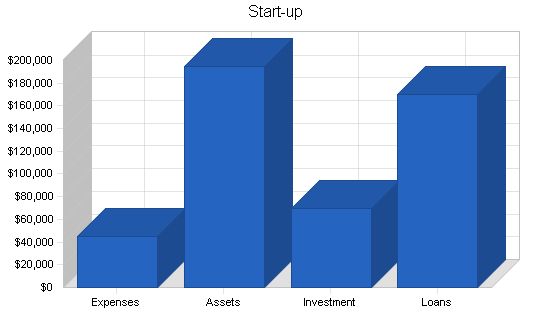
Start-up Expenses:
– Legal: $0
– Stationery: $600
– Liability insurance: $2,000
– Rent (3 months prior to opening): $8,000
– Computer: $1,200
– Licenses: $700
– Corporate design: $9,000
– Web design & implementation: $3,500
– Lease-hold improvements: $20,000
– Total Start-up Expenses: $45,000
Start-up Assets:
– Cash Required: $118,000
– Start-up Inventory: $12,000
– Other Current Assets: $0
– Long-term Assets: $65,000
– Total Assets: $195,000
Total Requirements: $240,000
Services:
UPer Crust Pies specializes in quality pies and pastries imported from the Upper Peninsula of Michigan. Our pies are low in fat, free of genetically modified ingredients, and made with premium ingredients. They are baked fresh every day and held at a steady temperature to ensure rapid service and high customer satisfaction.
We also sell frozen pies that can be cooked in an oven or microwave. Thanks to new technology, these pies can be heated in a microwave in less than three minutes while maintaining a flaky pastry texture.
In addition to pies, we offer premium salads, desserts, and cold beverages. We also provide savory samples to first-time visitors.
What is a Pie?
A pie is a traditional food consisting of savory fillings in a pastry shell. UPer Crust Pies aims to establish the humble meat pie as gourmet fare for Americans while bringing a taste of home to "UPers" living throughout America.
The Menu:
– The Classic Pie Selection (6.25 oz): Beef, Steak, Chicken & Vegetable, Bacon & Egg, Potato Top, Steak & Mushroom, Steak & Cheese, Beef & Cheese
– The Gourmet Pie Selection (9.5 oz): Thai Chicken, Bacon & Egg, Beef, Cheese & Tomato, Chicken & Vegetable, Butter Chicken, Cracked Pepper, Beef, Bacon & Double Cheese, Steak & Cheese, Vegetarian
– Rolls & Savories: Sausage rolls, beef rolls, garlic and cheese rolls, small savories
– Desserts & Fruit Pies: Cherry, apple, apricot, custard, apple, and a selection of cheese cakes
– Salads: Caesar Salad, Greek Salad, French Salad, Potato Salad, Fruit Salad
– Cold Beverages: Coke, Sprite, 7-Up, Carrot, Apple and Orange Juice, spring water, energy drinks
Market Analysis Summary:
The target market for UPer Crust Pies is the downtown Yubetchatown district, which is centrally located in the Bigriver Valley. Yubetchatown has a population of 84,560 and is projected to grow well over 100,000 by 2008. The area is home to a diverse economic base, including corporate offices, retail, industrial and manufacturing companies, and a large warehouse and distribution center. The median household income in the area is around $91,000, and the median age is 34 years old.
UPer Crust Pie’s customers will come from all age and income levels, with a focus on three separate groups: 15-24 year olds (including students), young adults and business people (25-34), and families with children under 14.
Market Segmentation:
UPer Crust Pies targets a wide customer base, but the primary segments for growth are:
– 15-24 Year Olds
– Young Adults and Businesspeople
– Families with Children
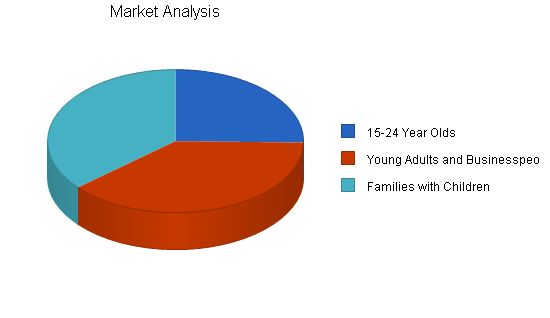
UPer Crust Pies will focus on attracting and educating new customers to create a loyal base. Our marketing strategies for the first year include highly visible signage and logos at each store, print media advertising in food and dining out guides, distribution of flyers with buy-one get one-free coupons to local businesses, and the use of entertainment book coupons. We will also rely on word-of-mouth advertising through our exceptional customer service and unique products. Additionally, we may establish alliances with Michigan Tourism to promote the Upper Peninsula. Our sales strategy will prioritize providing a fast and unique food alternative with high-quality ingredients and a memorable customer experience.
We aim to succeed by offering our customers delicious food and a pleasant environment, accompanied by excellent customer service. When customers visit our store, it is our responsibility to ensure that they have an enjoyable experience. To establish a loyal customer base, repeat business is of utmost importance.
Our pies will be cooked throughout the day to ensure freshness and taste. Additionally, we will provide free samples to first-time customers.
During peak times, we will offer fast service by having at least two employees available to assist customers. One employee will prepare orders while the other handles the sales transaction. We will analyze all sales data captured by our computerized POS system for marketing purposes.
To further encourage customers to eat at our pie shop, we will offer various promotions such as punch cards, meal deals, and weekly specials. By collecting customer feedback, we can identify which pies and associated foods sell well and tailor our offerings to local preferences.
We understand the importance of selling both the company and the product. Therefore, all employees will undergo comprehensive training to provide customers with the best possible experience. Our employees are empowered to resolve issues and are encouraged to seek assistance from managers when needed.
Part of our mission is to educate customers about pies in a respectful manner, as our knowledge should never make customers feel uncomfortable or ignorant.
In our first year of business, we will implement a Point-of-Sale (POS) computerized cash register system to enhance the tracking and management of receipts and charitable contributions. We will enlist the expertise of a professional experienced in integrating POS systems with the internet and inventory controls to establish technology guidelines for the company.
Our sales strategy relies on consistently delivering high-quality food, fast service, and a relaxed atmosphere. We can achieve this by:
– Hiring employees who appreciate our unique products.
– Continuously assessing all aspects of the business and addressing any issues promptly.
– Personally interacting with customers to let them know their feedback goes directly to the owners.
– Evaluating food choices and keeping popular items on the menu, while also introducing weekly and seasonal specials.
Our sales forecast for the first year (starting in July 2005) projects modest estimates. Cost control is a crucial focus for UPer Crust Pies, and to account for fluctuating economic conditions, we will negotiate a fixed purchase price for the first three years, as our product is imported from Michigan. Over these three years, we anticipate a 60% gross markup. In subsequent years, profitability will depend on keeping costs low and increasing sales.
Due to limited product awareness, market competition, and existing customer loyalty, we expect sales to be slow in the first three months. Therefore, we forecast a 5% growth rate for the first year. In the second and third years, we plan to open two additional stores each year. This expansion will nearly triple gross revenue in the second year and increase it by half again in the third year. Our growth rate projection for the first three years is a conservative 10%, compared to industry standards.
This sales forecast does not include the potential revenue generated from shipping our products via an e-commerce facility, which we plan to add to our website in the second year. Shipping could become a significant profit center based on current market research. It would also be a part of our marketing strategy to enhance brand recognition and product awareness.
We recognize that product sales will vary by season. Desserts and salads are expected to sell slightly more during the summer months due to barbecues and picnics. In contrast, pie and pastry sales are anticipated to be higher in winter, as they are perceived as comfort food. Soda sales are also expected to increase substantially during the summer months.
Please note that the sales forecast for the first year reflects the performance of store number one, with a 5% growth rate. In the second year, the forecast encompasses the combined sales of three stores, with a 10% growth rate. In the third year, the forecast includes the combined sales of five stores, also with a 10% growth rate.
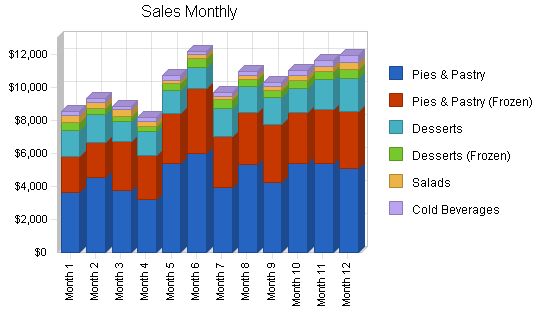
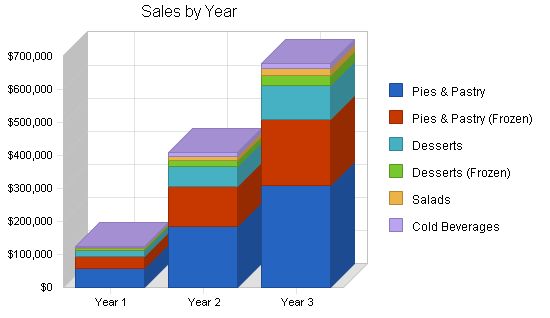
Sales Forecast
| Sales Forecast | |||
| Year 1 | Year 2 | Year 3 | |
| Sales | |||
| Pies & Pastry | $56,149 | $185,298 | $308,820 |
| Pies & Pastry (Frozen) | $36,531 | $120,552 | $200,921 |
| Desserts | $18,726 | $61,796 | $102,993 |
| Desserts (Frozen) | $5,444 | $17,965 | $29,942 |
| Salads | $3,586 | $11,834 | $19,723 |
| Cold Beverages | $3,154 | $10,408 | $17,347 |
| Total Sales | $123,589 | $407,853 | $679,746 |
| Direct Cost of Sales | Year 1 | Year 2 | Year 3 |
| Pies & Pastry | $19,652 | $61,904 | $103,173 |
| Pies & Pastry (Frozen) | $12,786 | $40,276 | $67,127 |
| Desserts | $6,554 | $20,645 | $34,409 |
| Desserts (Frozen) | $1,905 | $6,001 | $10,001 |
| Salads | $1,255 | $3,953 | $6,589 |
| Cold Beverages | $1,104 | $3,478 | $5,796 |
| Subtotal Direct Cost of Sales | $43,256 | $136,257 | $227,095 |
Web Plan Summary
In the first year of operation UPer Crust Pies will establish a basic Internet presence. The website will serve as a virtual business card and portfolio for the company with a simple, contemporary design to keep up with the latest trends in user interface. The site will provide general information about the company, its products, prices, store locations, hours of operation, and contact information.
In year two, the company will launch an e-commerce facility for customer ordering and shipping of frozen products throughout the U.S.
Website Marketing Strategy
Marketing efforts will start by informing our existing brick-and-mortar store customers about our Internet presence and encouraging their word-of-mouth recommendations. Further awareness will be heightened through search engine submissions, URL links, and e-mail marketing. The company website and email address will be referenced on all printed material and correspondence, including menus, business cards, and advertising media. The launching of our e-commerce facility for shipping in year two will also be marketed through word-of-mouth and on all printed media. Expansion into outside sales will help us create greater community awareness.
Development Requirements
– Site design: $1000 – $2,000.
– Website name registration for www.UPerCrustPies.com is $149.00 for 10 years.
– Site implementation: UPer Crust Pies will utilize the programming services of a friend with 12 years of experience in software development, including custom programming, data management, and web development.
Ongoing Costs:
– Site hosting: $19.95 per month. Includes 250 MB Disk Space, 10 GB Data transfer, and 20 POP e-mailboxes. (Year 1)
– Fully integrated e-commerce site hosting: $99.95 per month. Includes 5,000 MB Disk Space, 200 GB Data transfer, 200 POP e-mailboxes, storefront, and shopping cart, secure online credit card processing, and payment options. (Year 2)
– Search engine submission: $44.95 per month. Guaranteed placement in Google and Yahoo! (Year 2)
– Site design changes: Free of charge; however, material for changes such as photography, new logos, or designs may incur a fee but will be considered part of the marketing budget.
Management Summary
The strength of our management team positions us for success. We have assembled a team with expertise in all areas of the business. Overhead for management will be kept to a minimum, and initially, all managers will be hands-on workers. There is no intention of having a top-heavy organization that drains profits and complicates decisions.
UPer Crust Pies’ management style will encourage all employees to learn as much as possible about all aspects of the business and be involved in decision making where appropriate. The company respects its community of co-workers and will treat all workers well. It is important to us that they enjoy their jobs, feel part of the company, and are well rewarded for their work.
In addition to the day-to-day operations, the management team will oversee product development, purchasing, positioning, pricing, inventory control, approval of all financial obligations, and customer service policies and objectives.
Personnel Plan
UPer Crust Pies will be slow to hire people in the first year of operation, but very loyal to those who are hired. Initially, all employees will be part-time as the majority of work will be done by the owner. As the company grows, we intend to hire employees with relevant skills and reward them accordingly. From that point, we intend to increase the responsibilities of each employee as opposed to hiring more people.
Retail and restaurant businesses live or die on customer service, yet their employees have among the lowest pay and worst benefits of any industry. We know we have great products, but it’s the way those products are delivered that will determine our success. We realize that our employees are our biggest asset and that the image of our company is built by the people who work for us.
Compensation for employees will include direct monetary payments and performance bonuses for full-time employees. Because this is a small business, employees will be paid a comfortable wage that is fair to both the employees and the business.
Our opening employment goal is one full-time and one part-time employee with an additional two full-time and three part-time employees by the end of the second year. All employees will be trained in food handling and store procedures and will be required to hold a food handlers permit.
Our employee policies will include weekly management meetings, monthly employee meetings, ongoing training, performance reviews every six months, performance incentives, and encouragement of creativity.
Personnel Plan
| Personnel Plan | |||
| Year 1 | Year 2 | Year 3 | |
| Olie Mackinac-Gogebic | $27,040 | $27,040 | $29,120 |
| Misty Glade | $0 | $27,040 | $29,140 |
| Full-time Employee 1 | $0 | $27,040 | $27,040 |
| Lina Mackinac-Gogebic | $0 | $0 | $0 |
| Full-time Employee 2 | $0 | $0 | $24,960 |
| Full-time Employee 3 | $0 | $0 | $24,960 |
| Part-time Employee 1 | $7,000 | $7,000 | $9,000 |
| Part-time Employee 2 | $0 | $7,000 | $9,000 |
| Part-time Employee 3 | $0 | $7,000 | $9,000 |
| Name or Title or Group | $0 | $0 | $0 |
| Total People | 2 | 6 | 8 |
| Total Payroll | $34,040 | $102,120 | $162,220 |
A bank relationship will be established as soon as possible. Sales could increase at a much sharper rate than assumed in these conservative projections. Sharper sales will result in a greater need for funds in support of inventory and store growth, and a line of credit will need to be established. We will set a budget for marketing and advertising and will continue to reinvest residual profits into company expansion and personnel.
Sales growth will be aggressive during the first 18 months as we sharpen our product line and inventory. Although we anticipate substantial growth in years two and three, we are forecasting a very conservative 10% growth rate.
Important Assumptions
Payroll burden is calculated at an estimated 12.65%, made up of 7.65% for social security and medicare, 2% for unemployment, and 3% for worker’s compensation.
The tax rate has been left at 0% in the first year plan due to accumulated losses carried forward and that as an LLC, the owners will be taxed personally.
Our long-term interest rate is 6%.
Our State Sales tax is 4%. This does not affect our total profitability, but monthly payments to the State impact our cash flow and cash balance.
Our financial plan depends on important assumptions, including a slow-growth economy without major recession, no unforeseen changes in public health perceptions of our products, and access to sufficient capital to sustain the company’s projected growth plan.
Our break-even analysis is summarized in the following chart and table.
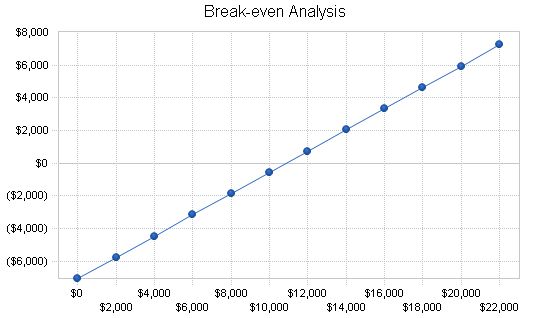
Break-even Analysis
Monthly Revenue Break-even: $10,862
Assumptions:
– Average Percent Variable Cost: 35%
– Estimated Monthly Fixed Cost: $7,060
Projected Profit and Loss (9.4)
The table and charts below show projected profit and loss.
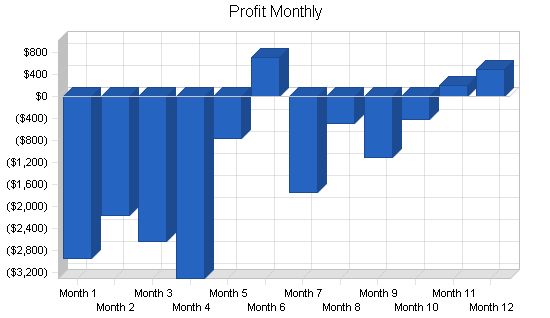
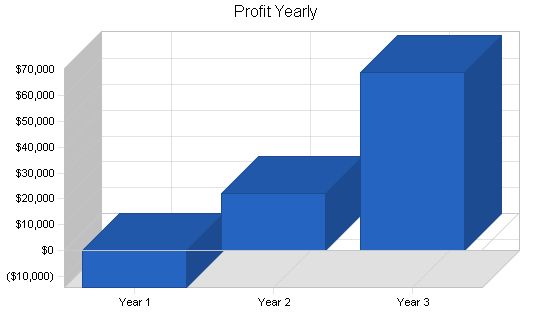
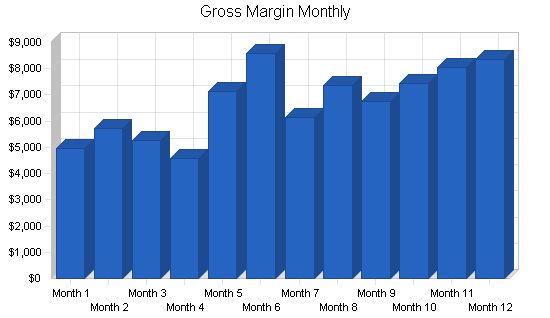
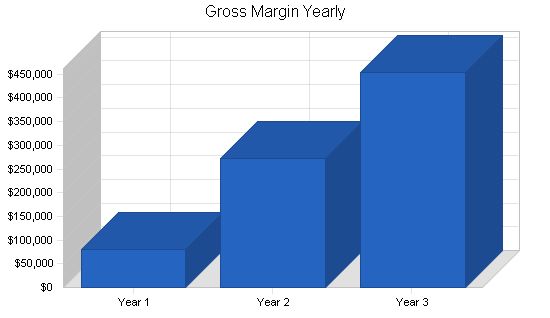
Pro Forma Profit and Loss:
| Pro Forma Profit and Loss | |||
| Year 1 | Year 2 | Year 3 | |
| $123,589 | $407,853 | $679,746 | |
| $43,256 | $136,257 | $227,095 | |
| $0 | $0 | $0 | |
| $43,256 | $136,257 | $227,095 | |
| $80,333 | $271,596 | $452,651 | |
| 65.00% | 66.59% | 66.59% | |
| $34,040 | $102,120 | $162,220 | |
| $3,000 | $9,000 | $15,000 | |
| $9,285 | $9,285 | $9,285 | |
| $24,000 | $72,000 | $120,000 | |
| $2,700 | $8,100 | $13,500 | |
| $2,400 | $7,200 | $12,000 | |
| $0 | $0 | $0 | |
| $0 | $0 | $0 | |
| $1,200 | $3,600 | $6,000 | |
| $1,500 | $5,000 | $7,000 | |
| $900 | $1,500 | $2,100 | |
| $500 | $1,500 | $2,500 | |
| $2,500 | $6,000 | $12,000 | |
| $500 | $1,000 | $2,000 | |
| $1,000 | $2,500 | $6,000 | |
| $1,000 | $2,000 | $5,000 | |
| $200 | $400 | $1,200 | |
| $84,725 | $231,205 | $375,805 | |
| ($4,392) | $40,391 | $76,846 | |
| $4,893 | $49,676 | $86,131 | |
| $9,810 | $9,060 | $8,160 | |
| $0 | $9,399 | $0 | |
| ($14,202) | $21,932 | $68,686 | |
| -11.49% | 5.38% | 10.10% | |
Projected Cash Flow:
9.5 Projected Cash Flow
Our projected cash flow is outlined in the following chart and table.
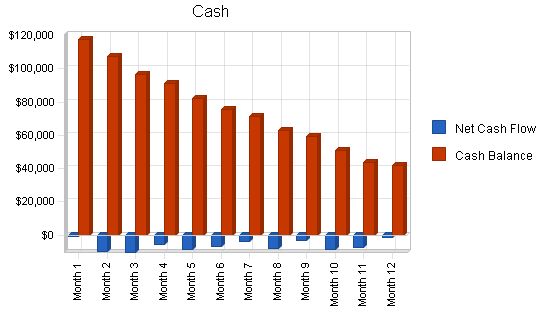
Pro Forma Cash Flow
| Pro Forma Cash Flow | |||
| Year 1 | Year 2 | Year 3 | |
| Cash Received | |||
| Cash from Operations | |||
| Cash Sales | $123,589 | $407,853 | $679,746 |
| Subtotal Cash from Operations | $123,589 | $407,853 | $679,746 |
| Additional Cash Received | |||
| Sales Tax, VAT, HST/GST Received | $4,944 | $16,314 | $27,190 |
| New Current Borrowing | $0 | $0 | $0 |
| New Other Liabilities (interest-free) | $0 | $0 | $0 |
| New Long-term Liabilities | $0 | $0 | $0 |
| Sales of Other Current Assets | $0 | $0 | $0 |
| Sales of Long-term Assets | $0 | $0 | $0 |
| New Investment Received | $0 | $60,000 | $60,000 |
| Subtotal Cash Received | $128,533 | $484,167 | $766,936 |
| Expenditures | |||
| Expenditures from Operations | |||
| Cash Spending | $34,040 | $102,120 | $162,220 |
| Bill Payments | $89,311 | $294,893 | $461,222 |
| Subtotal Spent on Operations | $123,351 | $397,013 | $623,442 |
| Additional Cash Spent | |||
| Sales Tax, VAT, HST/GST Paid Out | $4,466 | $16,314 | $27,190 |
| Principal Repayment of Current Borrowing | $0 | $0 | $0 |
| Other Liabilities Principal Repayment | $0 | $0 | $0 |
| Long-term Liabilities Principal Repayment | $12,000 | $14,000 | $16,000 |
| Purchase Other Current Assets | $0 | $0 | $0 |
| Purchase Long-term Assets | $65,000 | $30,000 | $30,000 |
| Dividends | $0 | $0 | $0 |
| Subtotal Cash Spent | $204,817 | $457,327 | $696,631 |
| Net Cash Flow | ($76,284) | $26,840 | $70,304 |
| Cash Balance | $41,716 | $68,556 | $138,861 |
9.6 Projected Balance Sheet
The following table explains the projected balance sheet.
| Pro Forma Balance Sheet | |||
| Year 1 | Year 2 | Year 3 | |
| Assets | |||
| Current Assets | |||
| Cash | $41,716 | $68,556 | $138,861 |
| Inventory | $16,744 | $52,744 | $87,906 |
| Other Current Assets | $0 | $0 | $0 |
| Total Current Assets | $58,460 | $121,300 | $226,767 |
| Long-term Assets | |||
| Long-term Assets | $130,000 | $160,000 | $190,000 |
| Accumulated Depreciation | $9,285 | $18,570 | $27,855 |
| Total Long-term Assets | $120,715 | $141,430 | $162,145 |
| Total Assets | $179,175 | $262,730 | $388,912 |
| Liabilities and Capital | |||
| Current Liabilities | |||
| Accounts Payable | $9,899 | $25,522 | $39,018 |
| Current Borrowing | $0 | $0 | $0 |
| Other Current Liabilities | $478 | $478 | $478 |
| Subtotal Current Liabilities | $10,376 | $26,000 | $39,496 |
| Long-term Liabilities | $158,000 | $144,000 | $128,000 |
| Total Liabilities | $168,376 | $170,000 | $167,496 |
| Paid-in Capital | $70,000 | $130,000 | $190,000 |
| Retained Earnings | ($45,000) | ($59,202) | ($37,270) |
| Earnings | ($14,202) | $21,932 | $68,686 |
| Total Capital | $10,798 | $92,730 | $221,416 |
| Total Liabilities and Capital | $179,175 | $262,730 | $388,912 |
| Net Worth | $10,798 | $92,730 | $221,416 |
9.7 Business Ratios
Projected business ratios are provided in the table below. The final column, Industry Profile, shows ratios for the Fast-Food Restaurant, Independent industry, as determined by the Standard Industry Classification (SIC) Index code 7999.
| Ratio Analysis | ||||
| Year 1 | Year 2 | Year 3 | Industry Profile | |
| Sales Growth | 0.00% | 230.01% | 66.66% | 8.67% |
| Percent of Total Assets | ||||
| Inventory | 9.35% | 20.08% | 22.60% | 3.24% |
| Other Current Assets | 0.00% | 0.00% | 0.00% | 37.31% |
| Total Current Assets | 32.63% | 46.17% | 58.31% | 45.97% |
| Long-term Assets | 67.37% | 53.83% | 41.69% | 54.03% |
| Total Assets | 100.00% | 100.00% | 100.00% | 100.00% |
| Current Liabilities | ||||
| Accounts Payable | 5.79% | 9.90% | 10.16% | 17.94% |
| Long-term Liabilities | 88.18% | 54.81% | 32.91% | 22.26% |
| Total Liabilities | 93.97% | 64.71% | 43.07% | 40.20% |
| Net Worth | 6.03% | 35.29% | 56.93% | 59.80% |
| Percent of Sales | ||||
| Sales | 100.00% | 100.00% | 100.00% | 100.00% |
| Gross Margin | 65.00% | 66.59% | 66.59% | 59.05% |
| Selling, General & Administrative Expenses | 76.49% | 61.21% | 56.49% | 39.24% |
| Advertising Expenses | 7.51% | 0.00% | 0.00% | 1.96% |
| Profit Before Interest and Taxes | -3.55% | 9.90% | 11.31% | 1.92% |
| Main Ratios | ||||
| Current | 5.63 | 4.67 | 5.74 | 1.04 |
| Quick | 4.02 | 2.64 | 3.52 | 0.66 |
| Total Debt to Total Assets | 93.97% | 64.71% | 43.07% | 50.22% |
| Pre-tax Return on Net Worth | -131.51% | 33.79% | 31.02% | 6.90% |
| Pre-tax Return on Assets | -7.93% | 11.93% | 17.66% | 13.87% |
| Additional Ratios | Year 1 | Year 2 | Year 3 | |
| Net Profit Margin | -11.49% | 5.38% | 10.10% | n.a |
| Return on Equity | -131.51% | 23.65% | 31.02% | n.a |
| Activity Ratios | ||||
| Inventory Turnover | 2.78 | 3.92 | 3.23 | n.a |
| Accounts Payable Turnover | 10.02 | 12.17 | 12.17 | n.a |
| Payment Days | 27 | 21 | 25 | n.a |
| Total Asset Turnover | 0.69 | 1.55 | 1.75 | n.a |
| Debt Ratios | ||||
| Debt to Net Worth | 15.59 | 1.83 | 0.76 | n.a |
| Current Liab. to Liab. | 0.06 | 0.15 | 0.24 | n.a |
| Liquidity Ratios | ||||
| Net Working Capital | $48,083 | $95,300 | $187,271 | n.a |
| Interest Coverage | -0.45 | 4.46 | 9.42 | n.a |
| Additional Ratios | Year 1 | Year 2 | Year 3 | |
| Assets to Sales | 1.45 | 0.64 | 0.57 | n.a |
| Current Debt/Total Assets | 6% | 10% | 10% | n.a |
| Acid Test |
Sales Forecast |
|||
| Sales Forecast | |||||||||||||
| Month 1 | Month 2 | Month 3 | Month 4 | Month 5 | Month 6 | Month 7 | Month 8 | Month 9 | Month 10 | Month 11 | Month 12 | ||
| Pies & Pastry | 5% | $3,644 | $4,559 | $3,772 | $3,208 | $5,426 | $6,020 | $3,934 | $5,360 | $4,234 | $5,426 | $5,435 | $5,131 |
| Pies & Pastry (Frozen) | 5% | $2,208 | $2,100 | $2,976 | $2,685 | $3,024 | $3,930 | $3,114 | $3,168 | $3,546 | $3,103 | $3,258 | $3,421 |
| Desserts | 5% | $1,536 | $1,707 | $1,213 | $1,442 | $1,392 | $1,299 | $1,730 | $1,548 | $1,625 | $1,451 | $1,792 | $1,992 |
| Desserts (Frozen) | 5% | $504 | $396 | $331 | $347 | $397 | $551 | $514 | $422 | $443 | $465 | $489 | $585 |
| Salads | 5% | $413 | $360 | $370 | $292 | $235 | $206 | $188 | $232 | $230 | $322 | $321 | $418 |
| Cold Beverages | 5% | $263 | $212 | $198 | $208 | $254 | $196 | $246 | $253 | $279 | $279 | $365 | $399 |
| Total Sales | $8,568 | $9,334 | $8,859 | $8,183 | $10,729 | $12,201 | $9,726 | $10,983 | $10,356 | $11,046 | $11,659 | $11,946 | |
Personnel Plan
| Personnel Plan | |||||||||||||
| Month 1 | Month 2 | Month 3 | Month 4 | Month 5 | Month 6 | Month 7 | Month 8 | Month 9 | Month 10 | Month 11 | Month 12 | ||
| Olie Mackinac-Gogebic | 0% | $2,253 | $2,253 | $2,253 | $2,253 | $2,253 | $2,253 | $2,253 | $2,253 | $2,253 | $2,253 | $2,253 | $2,253 |
| Misty Glade | 0% | $0 | $0 | $0 | $0 | $0 | $0 | $0 | $0 | $0 | $0 | $0 | $0 |
| Full-time Employee 1 | 0% | $0 | $0 | $0 | $0 | $0 | $0 | $0 | $0 | $0 | $0 | $0 | $0 |
| Lina Mackinac-Gogebic | 0% | $0 | $0 | $0 | $0 | $0 | $0 | $0 | $0 | $0 | $0 | $0 | $0 |
| Full-time Employee 2 | 0% | $0 | $0 | $0 | $0 | $0 | $0 | $0 | $0 | $0 | $0 | $0 | $0 |
| Full-time Employee 3 | 0% | $0 | $0 | $0 | $0 | $0 | $0 | $0 | $0 | $0 | $0 | $0 | $0 |
| Part-time Employee 1 | 0% | $583 | $583 | $583 | $583 | $583 | $583 | $583 | $583 | $583 | $583 | $583 | $583 |
| Part-time Employee 2 | 0% | $0 | $0 | $0 | $0 | $0 | $0 | $0 | $0 | $0 | $0 | $0 | $0 |
| Part-time Employee 3 | 0% | $0 | $0 | $0 | $0 | $0 | $0 | $0 | $0 | $0 | $0 | $0 | $0 |
| Name or Title or Group | 0% | $0 | $0 | $0 | $0 | $0 | $0 | $0 | $0 | $0 | $0 | $0 | $0 |
| Total People | 2 | 2 | 2 | 2 | 2 | 2 | 2 | 2 | 2 | 2 | 2 | 2 | |
Pro Forma Profit and Loss
| Pro Forma Profit and Loss | |||||||||||||
| Month 1 | Month 2 | Month 3 | Month 4 | Month 5 | Month 6 | Month 7 | Month 8 | Month 9 | Month 10 | Month 11 | Month 12 | ||
| Sales | $8,568 | $9,334 | $8,859 | $8,183 | $10,729 | $12,201 | $9,726 | $10,983 | $10,356 | $11,046 | $11,659 | $11,946 | |
| Direct Cost of Sales | $3,605 | $3,605 | $3,605 | $3,605 | $3,605 | $3,605 | $3,605 | $3,605 | $3,605 | $3,605 | $3,605 | $3,605 | |
| Other Costs of Sales | $0 | $0 | $0 | $0 | $0 | $0 | $0 | $0 | $0 | $0 | $0 | $0 | |
| Gross Margin | $4,963 | $5,729 | $5,254 | $4,578 |
Pro Forma Cash Flow is an essential tool for businesses to project and manage their cash flow. It provides a clear picture of the cash inflows and outflows for each month, enabling effective financial planning and decision-making. The table above outlines the cash received and spent over a 12-month period. The "Cash Received" section includes cash from operations, such as cash sales. The "Additional Cash Received" section includes additional sources of cash, such as sales tax received. On the other hand, the "Expenditures" section details the cash spent, including expenditures from operations and additional cash spent on items such as sales tax paid out and principal repayment of long-term liabilities. By analyzing the net cash flow, which is the difference between cash received and cash spent, businesses can determine their cash balance at the end of each month. This allows them to understand their financial position and make informed decisions moving forward. Overall, a thorough understanding of the pro forma cash flow is crucial for businesses to effectively manage their finances and ensure long-term success. |
||||||||
Hello!
I’m Andrew Brooks, a seasoned finance consultant from the USA and the mind behind phonenumber247.com.
My career is built on a foundation of helping individuals and businesses thrive financially in an ever-changing economic landscape. At phonenumber247.com, my aim is to demystify the complex world of finance, providing clear, actionable advice that can help you navigate your financial journey with confidence. Whether it’s personal finance management, investment strategies, or understanding the nuances of market dynamics, I’m here to share insights and tools that can propel you towards your financial goals.
Welcome to my digital space, where every piece of advice is a step closer to financial clarity and success!
